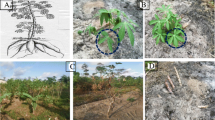Abstract
The need for an indigenous croplocally grown by subsistence farmers that willhelp bring direct economic benefits to thosewho need it most is very important. Cassava hasa great potential for this purpose if certainproblems are solved, because cassava has playedvital roles in the diet of many Africancountries especially the grassroot people, yetthe utilization of the crop in diversifiedforms has been very limited. There are few foodproducts from cassava that are processedindustrially with added value that will be ofhigher nutritional value and have longer shelflives. There are a number of traditionallyprocessed staple foods from cassava in Nigeriaand other African countries that needimprovement. Most of these foods can beimproved on if the market for them is assuredby the end users, a market that is currentlylacking. It will be necessary to create morepublic awareness within Nigeria and otherAfrican societies to increase the acceptabilityof such novel products and this requires amultidisciplinary approach to interpret whatscientists and technologists are doing to theold crop in the present age.
Similar content being viewed by others
References
Balagopalan, C., G. Padmaja, S. K. Nanada, and S. N. Moorthy (1988). Cassava in Food, Feed and Industry. Boca Raton, Florida: CRC Press.
Chukwuma, C. (1995). “Application of global concepts to the Nigerian food crisis. Economic planning in free societies.” Journal for Agriculture and Related Industries 31: 3–9.
CIAT report (1987). United States Agency for International Development. Bureau for Science and Technology, Office of Agriculture, Washington DC, USA.
Cock, J. H. (1985). Cassava: New Potential for a Neglected Crop. Boulder, Colorado: Westview Press.
Commodity Review (1993). Food and Agriculture Organisation Economic and Social Development Series, No. 51.
Counihan, C. and J. Penny (1997). Food and Culture. NewYork: Routledge.
de Bruijn, G. H. (1973). “The cyanogenic character of cassava.” In B. Nestle and R. MacIntyre (eds.), Chronic Cassava Toxicity, Vol. 10 (pp. 43–48). Ottawa: International Development Research Centre.
Hillcocks, R. J. (1997). “Cassava virus diseases and their control with special reference to southern Tanzania.” Integrated Pest Management Reviews 2(3): 125–138.
Howeler, R. H., G. T. Kurup, M. S. Palaniswami, V. P. Potty, G. Padmaja, S. Kabeerathumma, and S. V. Pillai (1996). “Diagnosis of nutritional disorders and soil fertility management of cassava.” In Tropical Tuber Crops: Problems, Prospects and Future Strategies (pp. 181–193). Lebanon, Pennsylvania: Science Publishers.
Horton, D. (1988). Underground Crops: Longterm Trends in Production of Roots and Tubers.Winrock International, USA.
IITA, (1998). “Cassava: A root crop for our time.” International Agricultural Development 18(1): 9–10.
Nwapa, F. (1986). The Cassava Song. Enugu, Nigeria: Tane Press.
Nwosu, H. N. (1986). “Rural development-our theory and practice.” A paper presented at the Seminar/Workshop for Pioneers of Rural Information Officers Corp at College of Agriculture, Ikwo, Anambra State, Nov. 10–14.
Ogunleye, R. (1992). “Expanding, yet fragile.” Timesweek, Lagos, Oct. 12, p. 28.
Okafor, N. (1977). Nigerian gari. Symposium on Indigenous Fermented Foods, Bangkok, Thailand. Ref. in K.H. Steinkraus (ed.), Handbook of Indigenous Fermented Foods. New York/Basel: Marcel Dekker, 1983.
Pechnic, E., L. R. Guimaraes, and A. Panek (1962). “Sobre o approveitamentao da folha de manioca, (Manihot sp.) na alimentaciao humana. II. Contribucao ao estudo do valor alimenticio, Arg. Bras.” Nutr. 18: 11.
Repo-Carrasco, R. (1992). Andean Crops and Infant Nourishment. University of Helsinki, Finland: Institute of Development Studies.
Tylleskär, T. (1994). The Causation of Konzo: Studies on a Paralytic Disease in Africa. PhD thesis, Faculty of Medicine, Uppsala University, Sweden.
UN World Economy Survey (1993). “Current trends and policies in the world economy.” Department of Economic and Social Information and Policy Analysis. New York: United Nations.
World Bank (1992). World Development Report 1992. Development and the Environment. New York: Oxford University Press.
Ximenes, T. (2001). “Division of labor and resource management in Eastern Para, Brazil.” Agriculture and Human Values 18(1): 49–56.
Author information
Authors and Affiliations
Rights and permissions
About this article
Cite this article
Raheem, D., Chukwuma, C. Foods from cassava and their relevance to Nigeria and other African countries. Agriculture and Human Values 18, 383–390 (2001). https://doi.org/10.1023/A:1015233606665
Issue Date:
DOI: https://doi.org/10.1023/A:1015233606665




